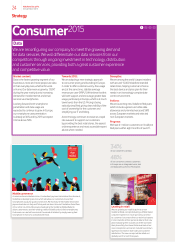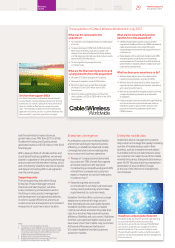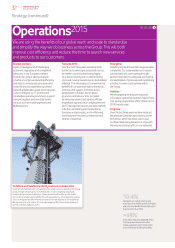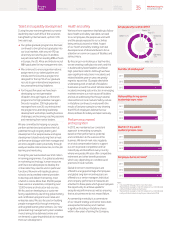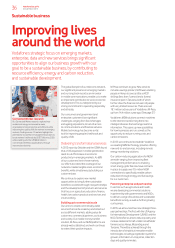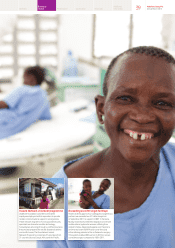Vodafone 2013 Annual Report Download - page 33
Download and view the complete annual report
Please find page 33 of the 2013 Vodafone annual report below. You can navigate through the pages in the report by either clicking on the pages listed below, or by using the keyword search tool below to find specific information within the annual report.
Strong network reach
As demand for mobile services moves from
voice and text to data we have been investing
to build a superior data network. Our data
network now covers 91% of the European
population, and we are aiming to reach 95%
coverage by 2015 – nearly on a par with our
voice coverage.
At the same time, smartphones are only going
to get faster, so we are constantly upgrading
our networks to support these future speed
demands. Today, we provide base-level
theoretical speeds of 14.4 Mbps across 98%
of our 3G network, typically giving customers
actual speeds of 2 to 3 Mbps – more than
enough to stream video or music, for example.
The next goal is to deliver another signicant
step up in the customer experience, with the
move to peak speeds of 43.2 Mbps across
much of our European 3G network. We are
aiming to upgrade 80% of the 3G footprint
in our ve major European markets to this
level by March 2015. For customers with
the latest smartphones, this will more than
double the speed they are currently enjoying,
and allow them to view video in high denition,
for example.
73%
of the trafc on our network is due to data
services such as video, email and internet
browsing on a mobile device.
91%
of the European population where
we operate is covered by our 3G network.
one trillion
minutes of calls were carried and more
than 330 petabytes of data were sent
across our networks – enough data for
4.4 trillion emails.
4G technology
We are beginning to build 4G (or LTE) networks,
which will at least double the data speeds
achievable over our 43.2 Mbps footprint. It will
also give us signicant additional capacity,
allowing us to stay ahead of the signicant
growth in data trafc that we forecast. We aim
to upgrade 40% of our coverage in our ve
main European markets to 4G by March 2015.
To maximise the potential of 4G, we have
invested £7.9 billion in spectrum in the last
four years. Much of this spectrum is in the very
valuable, low frequency 800 MHz band, which
allows much broader coverage, and much
better in-building connectivity, than higher
frequencies used in wireless networks.
We now have 4G services in seven countries
(Germany, Portugal, Italy, Romania, South
Africa, Greece and New Zealand). We are also
preparing for 4G launches in the UK, Spain,
Australia and the Netherlands in the 2014
nancial year.
Future proong our
network infrastructure
We are well prepared for rapid growth in data
trafc and a fast, but cost-effective, roll-out
of 4G services. At our base stations we are
consolidating equipment across several
technologies, including 4G, into a platform
called “single RAN” – allowing us to reduce
capex and operating costs. We have already
upgraded over half our European sites
to single RAN.
We are also increasing capacity in our
backhaul – the link between our base stations
and our nationwide core networks. 57% of our
European backhaul footprint is now capable
of handling one gigabit per second – which
is more than even the busiest base station
at full capacity will require based on current
technologies and projections.
Technological innovation
We are always looking for ways of innovating
in our network to improve our customers’
experience.
Recently we have been changing the way
we use spectrum to improve data coverage.
By moving 3G data trafc from its traditional
spectrum band (2.1 MHz) down to the 900
MHz band – a process known as “re-farming” –
we can signicantly improve our data coverage
and in-building reception, and we have done
this in ten markets.
Fixed network
In addition to our mobile businesses, we also
provide xed broadband and calls in 16
markets. We have started to modernise our
xed networks to deliver much higher data
speeds to the home, through a combination
of upgrades to traditional copper lines and the
introduction of the latest bre technology.
In Spain we are upgrading copper lines.
In Portugal, we are extending our bre
network, and in New Zealand, the acquisition
of TelstraClear gives us a high speed xed
network. We have also announced plans
in conjunction with Orange in Spain to build
a bre network which will pass 40% of homes
by 2017.
Elsewhere we are securing wholesale access
to third-party bre networks. In Germany
we have announced a next-generation
access agreement with Deutsche Telekom.
In Italy we have an agreement with Metroweb
to lease their bre in Milan. In New Zealand
we are interconnecting with a government
bre initiative called Ultra Fast Broadband,
in Qatar we interconnect with Qatari National
Broadband Networks and in the Netherlands
we are accessing KPN’s bre network allowing
us to cover 20% of homes.
UK 4G is nearly here
In February we successfully bid £803 million in the
UK spectrum auction for crucial low frequency (800
MHz) spectrum as well as more higher-frequency
spectrum to boost our existing network. 800 MHz
spectrum is great for transmitting a stronger, more
reliable signal and one that works well indoors. We
expect to launch our ultra-fast 4G service later this
year. The roll out of our 4G service is all part of around
£1.6 million we invest every single day in the UK on
our network to bring our customers coverage where
it matters.
Vodafone, the most preferred
operator in Turkey
Over the last 12 months the Turkish network has
been enhanced with the modernisation of nearly
1,100 legacy 2G sites with the latest single RAN
hardware and the implementation of around 1,200
and 2,500 new 2G and 3G sites respectively. We have
attained the number one position in independent
benchmark tests for data transfer speeds. Vodafone
is the rst telecommunications rm in Turkey to
be awarded the BS25999 certication for business
continuity, underlining our commitment to reliable
communication services for our customers. As a
result of our actions we are now seen as the preferred
operator in Turkey measured by benchmark net
promoter scores.
31 Vodafone Group Plc
Annual Report 2013
Overview Business
review Performance Governance Financials Additional
information





